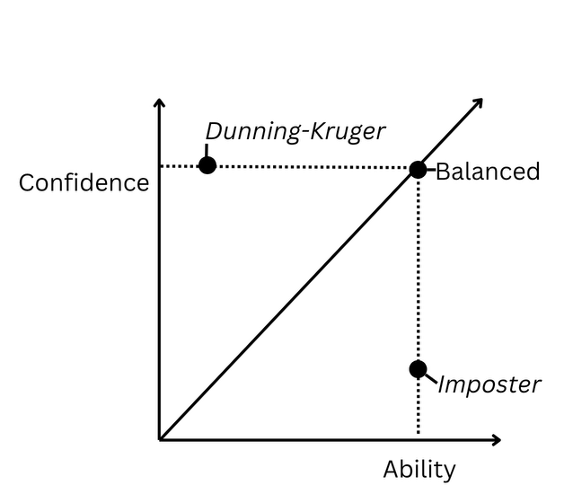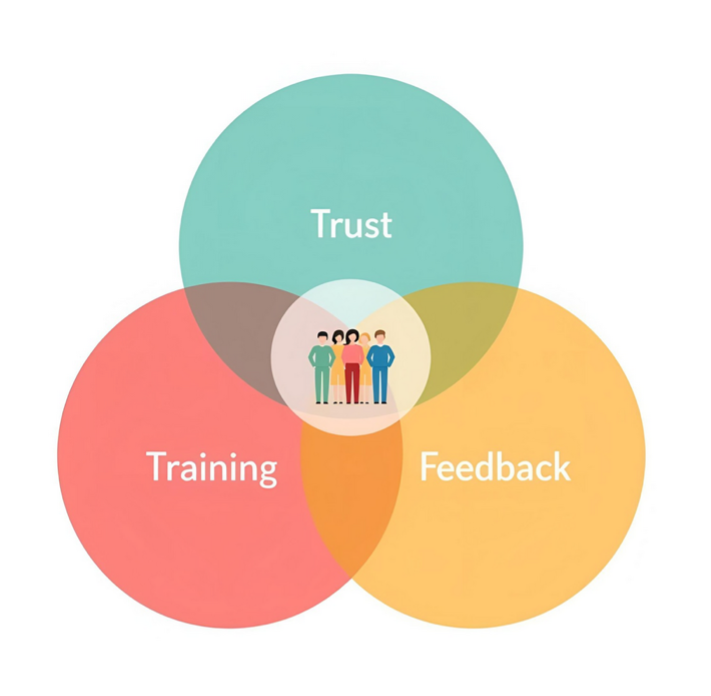Dr. Jillian Bohlen, Associate Professor and Dairy Extension Specialist
706-542-9108 / jfain@uga.edu
Every business faces what are often called “hidden threats.” In production agriculture, those threats might be dangerous situations or unnoticed vulnerabilities. While such risks can take many forms, some of the most damaging are the ones that come from within the workforce itself.
Although it may feel unusual to discuss, employee personality traits play a significant role in your business. Equally important to recognize is how important it is for owner, managers and coworkers to understand these traits. Common concerns regarding employee personality often centralize around burnout, failed leadership, weak organizational structure, and lack of recognition/reward. Less often acknowledged is the imbalance between an employee’s confidence and their ability, where ability includes both skills and knowledge.
Two scenarios discussed herein illustrate this imbalance (Figure 1). The first is Imposter Syndrome, in which ability is high, but self-confidence is low. The second is the Dunning-Kruger Effect, in which confidence is high, but ability is low.

Imposter Syndrome
Many people are familiar with the term “Imposter Syndrome” and might have used it in the past to describe themselves or others. This syndrome describes individuals who are cable but who experience persistent self-doubt. While everyone has moments of low confidence, this syndrome is different in that the doubt is chronic and extends across many activities. Those who experience it often set exceptionally high standards for themselves and may feel undeserving of their position; hence, the term “imposter”. This is coupled by a fear that others will eventually find out that they are incapable. On the farm, this pattern of behavior can be frustrating to management and coworkers as the employee is prone to procrastination, over questioning and failure to work as part of a team. Yet these behaviors usually stem from fear rather than lack of ability.
The costs are real. These individuals tend to over prepare, take extra time to complete tasks or may hesitate to begin new tasks or take on new responsibilities (procrastination). All affect the farm’s efficiency. In these employees, burnout and absenteeism become more likely, with turnover often following. This can result in time for retraining as well as lost talent. Managers may also miss opportunities to develop these capable employees for long-term strengthening of the workforce.
Imposter Syndrome is not rare but recognizing it requires careful observation. While the business world finds this condition in greater frequency for those with high leadership roles (>60%), it can affect employees at all stages of their career. These employees tend to work long hours and may often appear as perfectionists. They tend to have high expectations of themselves and at times, others. This is largely coupled with them having poor initiative and drive for tackling new tasks or responsibilities. They often prefer to work alone, for fear that they are discovered as incapable and are modest when receiving praise.
Supporting these employees involves normalizing feelings of doubt, encouraging open communication, and providing structured mentorship. Supporting employees with Imposter Syndrome is not a one-man job. It is also not about fighting the employee’s “inner critic”, which is a losing proposition. Instead, assigning tasks that align with existing strengths can help build confidence over time. Coupling this with positive and genuine feedback will also allow them to progress. A mentorship program should be part of the employee environment at any farm but becomes even more important when employees have an imbalance in confidence and ability. This mentorship can allow more open dialogue and conversations of trust while also providing the person with a critical support system. These strategies strengthen not only individuals but also the overall workplace culture.
Dunning-Kruger Effect
The Dunning-Kruger Effect represents the opposite side of this imbalance. Here, employees display high confidence without the ability to match. An example often used to describe this condition is driving. Most people believe their driving ability is far superior to those of the average driver, despite having equal or less experience and understanding. In many of these cases, their confidence exceeds the reality of their abilities. On the farm, this effect arises when employees confidently tackle work tasks while lacking knowledge and failing to recognize the discrepancy.
The impact can range from costly mistakes with individual animals to poor investment decisions at the farm level. These employees often fail to recognize their shortcomings; therefore, they rarely seek guidance, which can result in long term impacts to the farm. The naming of this effect sources from two psychologists that wanted to study why people make obviously bad decisions in business while believing they are correct.
Recognizing those with issues associated with the Dunning-Kruger effect is often tricky. These employees seem confident, motivated and ready to hit the ground running. However, their short comings may only be discovered through discussions with other employees they work closely with or looking at patterns of issues where the employee may be the common thread. Interestingly, while failing to see their own inadequacies, they also often fail to recognize the skills and abilities of others. This combination means they seldom seek advice or support from other employees or management. It is important to note that this effect is not all encompassing in a person’s life but may only show up in certain situations or conditions.
Support begins with limiting decision-making authority until confidence and ability are better aligned. Identifying trusted and respected employees who demonstrate the right balance and using them as mentors can provide both guidance and perspective. Narrowing responsibilities and ensuring thorough training in specific areas allow growth without exposing the farm to unnecessary risk. While the employee may seem like the source of the issue, ultimately, management bears much of the responsibility. Complete training protocols, continuous learning opportunities, and developing a culture where constructive criticism is sought and given are critical in reducing the risks of the Dunning-Kruger Effect.
Conclusion
Every employee has value, and it is management that determines how that value is realized. Whether the challenge is Imposter Syndrome, the Dunning-Kruger Effect, or others, the solution rests on the same foundation: trust, training, and feedback (Figure 2). By understanding and addressing these imbalances, managers can strengthen their workforce, improve efficiency, and reduce hidden threats.

